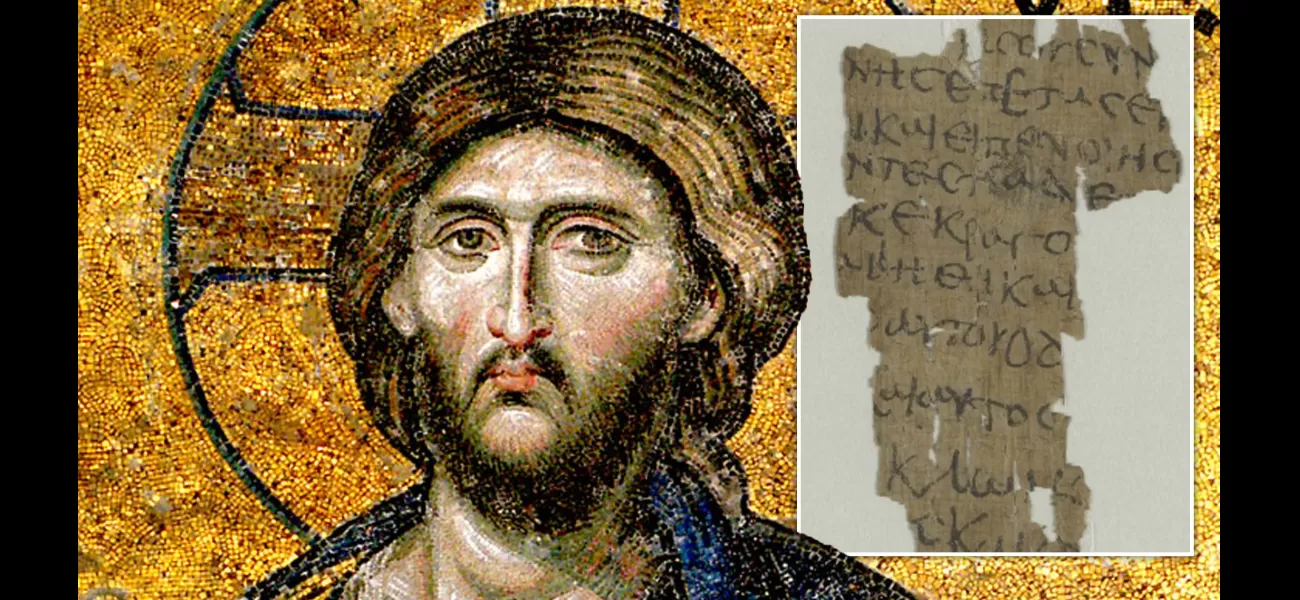Experts find earliest evidence of young Jesus doing miracle in new discovery
The text is written in Greek.
June 12th 2024.

In the time of Jesus Christ, it was said that he performed many miracles that amazed and inspired people. And now, we have just discovered a piece of ancient papyrus that tells the story of one of his lesser-known miracles. This revelation comes from a team of researchers from Germany and Belgium who stumbled upon a fragment of papyrus detailing the 'vivification of the sparrows'. It is said that Jesus, only five years old at the time, was able to turn clay pigeons into living birds.
This incredible 2,000 year-old text was found in an ancient Egyptian manuscript, but it was the clumsy handwriting that led the researchers to believe it was part of a school exercise from the 4th or 5th Century. However, the original story is thought to have been written in the 2nd Century as part of the Infancy Gospel of Thomas, a book that recounts the childhood of Christ. Surprisingly, this papyrus fragment went unnoticed in the Hamburg State and University Library in Germany until now. At first glance, it was mistaken for an everyday document like a shopping list due to the unrefined handwriting.
Dr Lajos Berkes, a papyrologist involved in the research, explained, "We first noticed the word Jesus in the text. Then, by comparing it with numerous other digitized papyri, we were able to decipher it letter by letter and quickly realized that it could not be an everyday document." Through this analysis, the researchers were able to determine that this is the earliest known copy of Jesus Christ performing a miracle as a child. Dr Berkes added, "The fragment is of extraordinary interest for research, not only because it is the earliest known copy, but also because it offers new insights into the transmission of the text."
The fragment, measuring four inches by two inches, contains 13 Greek lines and will be published in the journal of Zeitschrift für Papyrologie und Epigraphik. According to Dr Gabriel Nocchi Macedo from the University of Liège, this discovery confirms that the Infancy Gospel of Thomas was originally written in Greek. This gospel, though not included in the Bible due to uncertainty about its author, was widely circulated among early Christian communities during the medieval period.
The text on the ancient papyrus describes the miracle of vivification of the sparrows, also known as Jesus's 'second miracle'. It tells the story of a young Jesus molding 12 sparrows out of clay. At first, Joseph, Jesus's legal father, scolded him for doing this on the Sabbath. But when Jesus clapped his hands, the clay figures came to life and flew away. This miracle, though not mentioned in the Bible, adds to the many other extraordinary wonders performed by Jesus Christ.
Before this discovery, the earliest known version of the Gospel of Thomas was believed to be from an 11th Century codex. However, with this new record, we can now trace the text back to the 4th or 5th Century, giving us a better understanding of its transmission and impact. This fascinating find sheds new light on the miracles of Jesus and his childhood, adding to the already vast and wondrous legacy of this remarkable figure.
This incredible 2,000 year-old text was found in an ancient Egyptian manuscript, but it was the clumsy handwriting that led the researchers to believe it was part of a school exercise from the 4th or 5th Century. However, the original story is thought to have been written in the 2nd Century as part of the Infancy Gospel of Thomas, a book that recounts the childhood of Christ. Surprisingly, this papyrus fragment went unnoticed in the Hamburg State and University Library in Germany until now. At first glance, it was mistaken for an everyday document like a shopping list due to the unrefined handwriting.
Dr Lajos Berkes, a papyrologist involved in the research, explained, "We first noticed the word Jesus in the text. Then, by comparing it with numerous other digitized papyri, we were able to decipher it letter by letter and quickly realized that it could not be an everyday document." Through this analysis, the researchers were able to determine that this is the earliest known copy of Jesus Christ performing a miracle as a child. Dr Berkes added, "The fragment is of extraordinary interest for research, not only because it is the earliest known copy, but also because it offers new insights into the transmission of the text."
The fragment, measuring four inches by two inches, contains 13 Greek lines and will be published in the journal of Zeitschrift für Papyrologie und Epigraphik. According to Dr Gabriel Nocchi Macedo from the University of Liège, this discovery confirms that the Infancy Gospel of Thomas was originally written in Greek. This gospel, though not included in the Bible due to uncertainty about its author, was widely circulated among early Christian communities during the medieval period.
The text on the ancient papyrus describes the miracle of vivification of the sparrows, also known as Jesus's 'second miracle'. It tells the story of a young Jesus molding 12 sparrows out of clay. At first, Joseph, Jesus's legal father, scolded him for doing this on the Sabbath. But when Jesus clapped his hands, the clay figures came to life and flew away. This miracle, though not mentioned in the Bible, adds to the many other extraordinary wonders performed by Jesus Christ.
Before this discovery, the earliest known version of the Gospel of Thomas was believed to be from an 11th Century codex. However, with this new record, we can now trace the text back to the 4th or 5th Century, giving us a better understanding of its transmission and impact. This fascinating find sheds new light on the miracles of Jesus and his childhood, adding to the already vast and wondrous legacy of this remarkable figure.
[This article has been trending online recently and has been generated with AI. Your feed is customized.]
[Generative AI is experimental.]
0
0
Submit Comment





